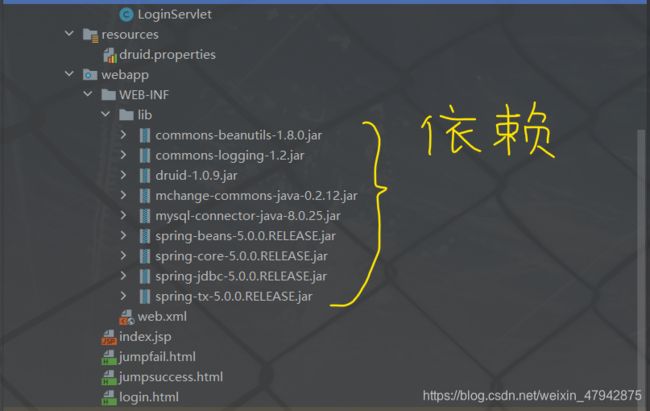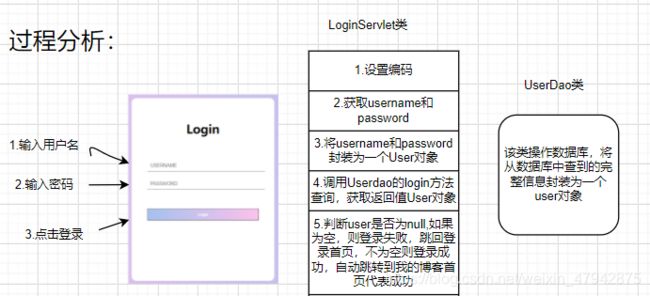前后端交互:登录案例(详细描述)
今天又是学习的一天呐(敲代码改Bug加摸鱼…)
文章目录
-
- 今天又是学习的一天呐(敲代码改Bug加摸鱼...)
- 前言:
- 登录案例描述:
- 项目结构:
- 项目分析:
- 数据库:
- druid.properties
- 用户实体类:User
- JDBC工具类:JDBCUtils
- 操作数据库中User表的类:UserDao
- 测试类:UserDaoTest
- 登录的具体逻辑:LoginServlet:
- 数据封装类测试:BeanUtilsTest:
- 登录主页:login.html
- 登录失败跳转:jumpfail.html
- 登录成功跳转:jumpsuccess.html
- 启动项目:
- 最终效果:
前言:
通过这几天在(B站大学)学习的 数据库连接池, Request,Http协议,servlet,等一系列JavaWeb相关知识,今天就写一篇基于前后端交互的登录案例文章,但由于知识有限,边学边做,功能很简陋,用户体验一般般,后期会在更一篇完善的文章的。发这篇文章的目的是巩固巩固这几天的所学知识,同时也分享一下,不足之处欢迎看到的大佬指点!
登录案例描述:
- 登录首页:可以输入用户名和密码,有登录按钮,美观,大方!
- 使用Druid数据库连接池技术,操作mysql的login1数据库中的user表
- 使用JdbcTemplate技术封装JDBC
- 用户点击登录按钮,后台程序判断数据库user表里有没有此人,若有此人,在判断用户名、密码是否正确,都正确则登录成功,否则登录失败。
- 登录成功,则5s后跳转到我的博客首页
- 登录失败,则5s后返回登录首页,可以重新登录
项目结构:
项目分析:
数据库:
create database login1;
use login1;
create table user(
id int primary key auto_increment,
username varchar(32) unique not null,
password varchar(32) not null
);
insert into user values(1,"AAA","123");
insert into user values(2,"小明","123456");
druid.properties
(password为自己的密码)
driverClassName=com.mysql.cj.jdbc.Driver
url=jdbc:mysql://127.0.0.1:3306/login1
username=root
password=******
#初始化连接数量
initialSize=5
#最大连接数
maxActive=10
maxWait=3000
filters=stat
timeBetweenEvictionRunsMillis=60000
minEvictableIdleTimeMillis=300000
validationQuery=SELECT 1
testWhileIdle=true
testOnBorrow=false
testOnReturn=false
poolPreparedStatements=false
maxPoolPreparedStatementPerConnectionSize=200
用户实体类:User
package com.example.LoginCase;
/**
* 用户的实体类
*/
public class User {
private int id;
private String username;
private String password;
private String gender;
public void setHehe(String gender){
this.gender = gender;
}
public String getHehe(){
return gender;
}
public int getId() {
return id;
}
public void setId(int id) {
this.id = id;
}
public String getUsername() {
return username;
}
public void setUsername(String username) {
this.username = username;
}
public String getPassword() {
return password;
}
public void setPassword(String password) {
this.password = password;
}
@Override
public String toString() {
return "User{" +
"id=" + id +
", username='" + username + '\'' +
", password='" + password + '\'' +
", gender='" + gender + '\'' +
'}';
}
}
JDBC工具类:JDBCUtils
package util;
import com.alibaba.druid.pool.DruidDataSourceFactory;
import javax.sql.DataSource;
import javax.xml.crypto.Data;
import java.io.IOException;
import java.io.InputStream;
import java.sql.Connection;
import java.sql.SQLException;
import java.util.Properties;
/**
* JDBC工具类 使用Durid连接池
*/
public class JDBCUtils {
private static DataSource ds ;
static {
try {
//1.加载配置文件
Properties pro = new Properties();
//使用ClassLoader加载配置文件,获取字节输入流
InputStream is = JDBCUtils.class.getClassLoader().getResourceAsStream("druid.properties");
pro.load(is);
//2.初始化连接池对象
ds = DruidDataSourceFactory.createDataSource(pro);
} catch (IOException e) {
e.printStackTrace();
} catch (Exception e) {
e.printStackTrace();
}
}
/**
* 获取连接池对象
*/
public static DataSource getDataSource(){
return ds;
}
/**
* 获取连接Connection对象
*/
public static Connection getConnection() throws SQLException {
return ds.getConnection();
}
}
操作数据库中User表的类:UserDao
package dao;
import com.example.LoginCase.User;
import org.springframework.dao.DataAccessException;
import org.springframework.jdbc.core.BeanPropertyRowMapper;
import org.springframework.jdbc.core.JdbcTemplate;
import util.JDBCUtils;
/**
* 操作数据库中User表的类
*/
public class UserDao {
//声明JDBCTemplate对象共用
private JdbcTemplate template = new JdbcTemplate(JDBCUtils.getDataSource());
/**
* 登录方法
*
* @param loginUser 只有用户名和密码
* @return user包含用户全部数据, 没有查询到,返回null
*/
public User login(User loginUser) {
try {
//1.编写sql
String sql = "select * from user where username = ? and password = ?";
//2.调用query方法
User user = template.queryForObject(sql,
new BeanPropertyRowMapper<User>(User.class),
loginUser.getUsername(), loginUser.getPassword());
return user;
} catch (DataAccessException e) {
e.printStackTrace();//记录日志
return null;
}
}
}
测试类:UserDaoTest
package test;
import com.example.LoginCase.User;
import dao.UserDao;
import org.testng.annotations.Test;
public class UserDaoTest {
@Test
public void testLogin(){
User loginuser = new User();
loginuser.setUsername("AAA");
loginuser.setPassword("123");
UserDao dao = new UserDao();
User user = dao.login(loginuser);
System.out.println(user);
}
}
登录的具体逻辑:LoginServlet:
package web.servlet;
import org.apache.commons.beanutils.BeanUtils;
import com.example.LoginCase.User;
import dao.UserDao;
import javax.servlet.ServletException;
import javax.servlet.annotation.WebServlet;
import javax.servlet.http.HttpServlet;
import javax.servlet.http.HttpServletRequest;
import javax.servlet.http.HttpServletResponse;
import java.io.IOException;
import java.lang.reflect.InvocationTargetException;
import java.util.Map;
@WebServlet("/loginServlet")
public class LoginServlet extends HttpServlet {
@Override
protected void doGet(HttpServletRequest req, HttpServletResponse resp) throws ServletException, IOException {
//1.设置编码
req.setCharacterEncoding("utf-8");
/* //2.获取请求参数
String username = req.getParameter("username");
String password = req.getParameter("password");
//3.封装user对象
User loginUser = new User();
loginUser.setUsername(username);
loginUser.setPassword(password);*/
//2.获取所有请求参数
Map<String, String[]> map = req.getParameterMap();
//3.创建User对象
User loginUser = new User();
//3.2使用BeanUtils封装
try {
BeanUtils.populate(loginUser,map);
} catch (IllegalAccessException e) {
e.printStackTrace();
} catch (InvocationTargetException e) {
e.printStackTrace();
}
//4.调用UserDao的login方法
UserDao dao = new UserDao();
User user = dao.login(loginUser);
//5.判断user
if(user == null){
//登录失败
//跳转页面语句
resp.sendRedirect("/jumpfail.html");
}else{
//登录成功
//跳转页面语句
resp.sendRedirect("/jumpsuccess.html");
}
}
@Override
protected void doPost(HttpServletRequest req, HttpServletResponse resp) throws ServletException, IOException {
this.doGet(req,resp);
}
}
数据封装类测试:BeanUtilsTest:
package test;
import com.example.LoginCase.User;
import org.testng.annotations.Test;
import java.lang.reflect.InvocationTargetException;
import org.apache.commons.beanutils.BeanUtils;
public class BeanUtilsTest {
@Test
public void test(){
User user = new User();
try {
BeanUtils.setProperty(user,"hehe","male");
System.out.println(user);
String gender = BeanUtils.getProperty(user, "hehe");
System.out.println(gender);
} catch (IllegalAccessException e) {
e.printStackTrace();
} catch (InvocationTargetException e) {
e.printStackTrace();
} catch (NoSuchMethodException e) {
e.printStackTrace();
}
}
}
登录主页:login.html
DOCTYPE html>
<html lang="en">
<head>
<meta charset="UTF-8">
<meta name="viewport" content="width=device-width, initial-scale=1.0">
<title>Documenttitle>
<style>
* {
margin: 0;
padding: 0;
}
html {
height: 100%;
}
body {
height: 100%;
}
.container {
height: 100%;
background-image: linear-gradient(to right, #fbc2eb, #a6c1ee);
}
.login-wrapper {
background-color: #fff;
width: 358px;
height: 588px;
border-radius: 15px;
padding: 0 50px;
position: relative;
left: 50%;
top: 50%;
transform: translate(-50%, -50%);
}
.header {
font-size: 38px;
font-weight: bold;
text-align: center;
line-height: 200px;
}
.input-item {
display: block;
width: 100%;
margin-bottom: 20px;
border: 0;
padding: 10px;
border-bottom: 1px solid rgb(128, 125, 125);
font-size: 15px;
outline: none;
}
.input-item::placeholder {
text-transform: uppercase;
}
.btn {
text-align: center;
padding: 10px;
width: 100%;
margin-top: 40px;
background-image: linear-gradient(to right, #a6c1ee, #fbc2eb);
color: #fff;
}
a {
text-decoration-line: none;
color: #abc1ee;
}
style>
head>
<body>
<div class="container">
<div class="login-wrapper">
<div class="header">Logindiv>
<div class="form-wrapper">
<form action="/loginServlet" method="post">
<input type="text" name="username" placeholder="username" class="input-item">
<input type="password" name="password" placeholder="password" class="input-item">
<input type="submit" class="btn" value="Login">
form>
div>
div>
div>
body>
html>
登录失败跳转:jumpfail.html
DOCTYPE html>
<html lang="en">
<head>
<meta charset="UTF-8">
<meta http-equiv="X-UA-Compatible" content="IE=edge">
<meta name="viewport" content="width=device-width, initial-scale=1.0">
<title>Documenttitle>
<style>
p{
text-align: center;
font-size: 50px;
}
#time{
color: red;
}
style>
head>
<body>
<form action="/tz">
<p>用户名或密码错误!p>
<p>
<span id="time">5span>秒后跳回登录页面...
p>
form>
<script>
var obj=document.getElementById("time");
var count=5;
function fun(){
count--;
if(count<=1){
location.href = "/login.html";
/* clearInterval(id); */
}
obj.innerHTML=count+"";
}
var id= setInterval(fun,1000);
script>
body>
html>title>
head>
<body>
body>
html>
登录成功跳转:jumpsuccess.html
DOCTYPE html>
<html lang="en">
<head>
<meta charset="UTF-8">
<meta http-equiv="X-UA-Compatible" content="IE=edge">
<meta name="viewport" content="width=device-width, initial-scale=1.0">
<title>Documenttitle>
<style>
p{
text-align: center;
font-size: 50px;
}
#time{
color: red;
}
style>
head>
<body>
<form action="/tz">
<p>登录成功!p>
<p>
<span id="time">5span>秒后跳转到我的博客首页...
p>
form>
<script>
var obj=document.getElementById("time");
var count=5;
function fun(){
count--;
if(count<=1){
location.href = "https://blog.csdn.net/weixin_47942875?spm=1011.2124.3001.5343";
/* clearInterval(id); */
}
obj.innerHTML=count+"";
}
var id= setInterval(fun,1000);
script>
body>
html>title>
head>
<body>
body>
html>
启动项目:
浏览器输入:localhost:8080/login.html 进入登录页面
最终效果:
(CSDN对视频不太友好,我转成gif图了)



